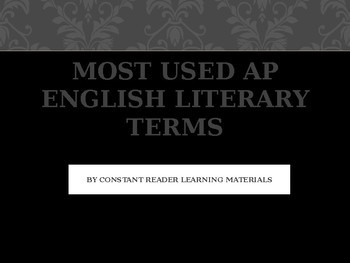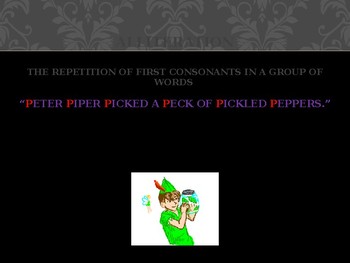Most Used AP English Literary Terms PowerPoint Presentation
- PPTX
Description
This 103-slide PPT presentation covers more than 130 of the most-often-used literary terms found on the Advanced Placement / AP English Language and Composition and AP English Literature and Composition exams.
The presentation is also useful for 8-12 grade non- AP / Advanced Placement courses including honors, gifted and talented, and on-level.
Terms range from allegory and alliteration to understatement and verse.
Each slide provides the term, definition, examples, and an image to help students remember the definition or to help define the term. More than 100 images have been included.
The presentation is dynamic without being gaudy so as to maintain student attention.
It is recommended that this presentation be spread out over several days. A word or two per day would make a good warm up.
Terms include at least:
1. allegory
2. alliteration
3. allusion
4. analogy
5. anaphora
6. annotation
7. antagonist
8. antihero
9. antithesis
10. aphorism
11. apostrophe
12. archetype
13. assonance
14. atmosphere
15. ballad
16. blank verse
17. cacophony
18. euphony
19. caesura
20. characterization
21. climax
22. cliche
23. colloquialism
24. conflict
25. human vs. nature
26. human vs. machine
27. human vs. gods
28. human vs. the supernatural
29. connotation
30. human vs. human
31. human vs. self
32. human vs. society
33. denotation
34. consonance
35. couplets
36. dialect
37. denouement
38. diction
39. elegy
40. end rhyme
41. end-stopped line
42. enjambment
43. epic poem
44. epigraph
45. epithet
46. eulogy
47. euphony
48. explication
49. eye rhyme
50. fable
51. farce
52. figurative language
53. foil
54. meter
55. foot
56. foreshadowing
57. free verse
58. genre
59. hyperbole
60. internal rhyme
61. inversion
62. irony
63. lyric
64. juxtaposition
65. metonymy
66. synecdoche
67. metaphor
68. extended metaphor
69. mixed metaphor
70. monologue
71. mood
72. tone
73. motif
74. myth
75. legend
76. narrative poem
77. near rhyme
78. oblique rhyme
79. half rhyme
80. imperfect rhyme
81. slant rhyme
82. octet
83. sestet
84. ode
85. onomatopoeia
86. oxymoron
87. parable
88. paradox
89. parallel structure
90. parallelism
91. parody
92. pastoral
93. persona
94. personification
95. anthropomorphism
96. zoomorphism
97. plot
98. exposition
99. rising action
100. climax
101. resolution
102. points of view
103. prose poem
104. protagonist
105. quatrain
106. pun
107. antagonist
108. refrain
109. rhetoric
110. rhetorical question
111. rhyme
112. romance
113. sarcasm
114. romantic
115. satire
116. simile
117. soliloquy
118. sonnet
119. shakespearean (aka: elizabethan and english) sonnets
120. petrarchan or italian sonnet
121. spencerian sonnet
122. stanza
123. tercet
124. couplet
125. stereotype
126. stream of consciousness
127. subplot
128. symbolism
129. syntax
130. theme
131. understatement
132. verse





